See Guangzhou again-On the Bell Tower, Guangzhou Lu Xun Memorial Hall
Walking time: 2020.7
D1:
Walking method: Self-driving by plane (Nanjing-Guangzhou)
Walking route: Nanhai Temple (Tour time: 1.5 hours, ticket: 15 yuan) Lingnan Impression (Arrived at 16:40, closed at 5 o'clock, unable to enter) Guangzhou University Town Science and Technology Museum (appearance) Foraging on Beijing Road
Check-in: CityNote Sinoo Hotel (Guangzhou Beijing Road Dafosi Park Front Subway Station Branch)271 yuan/standard room
D2:
Walking method: walking, renting
Walking routes: Lu Xun Memorial Hall (1.5 hours, online reservation in advance, tickets are not available), Guangdong Museum (1.5 hours, online reservation in advance, tickets are not available), United Bookstore
Check-in: Beijing Road Sino Hotel
D3:
Walking methods: walking, subway
Walking routes: Nanyue Palace Museum (1.5 hours, no tickets), Yuexiu Park (2 hours, online reservation in advance, no tickets), Guangzhou Museum, Yuehai Tower Foraging
Check-in: Jinzhou International Hotel
D4:
Walking method: walking, renting
Walking routes: Sun Yat-sen Memorial Hall (free tickets for medical staff), Beijing Road, Tao Tao Ju foraging
Check-in: Huamao Hotel
D5:
Walking methods: bus, taxi, subway, plane (Guangzhou-Nanjing)
Walking route: Shangxia Ninth Street, Xiguan Dawu, Liwan Lake Park, Xintai Le Dining
D2:
CityNote Chino Hotel is located on Longzang Street, walking a few steps to Xihu Road. This big pigeon rice is authentic Cantonese food, but after staying here for two days, I saw that there were long queues waiting for meals every day. I wanted to try it, but I really didn't have the patience. It seems that he is not a foodie!

A few steps east, there is actually a huge Guangzhou Giant Buddha Temple. From the outside, the ancient temples and temples of the Great Buddha imitate the standard of the official temples in the capital, which combines the local style of Lingnan. The ancient temple has a construction area of 1200 square meters and is still the crown of Lingnan. The top of the Xie Mountain is covered with plain treads, tiles and hook heads, dripping water, gray plastic tile ridges of bamboo dragons, peonies and other ridges.

There is a picture board in front of the temple introducing the etiquette and culture of the temple. He just looked up at its glorious appearance from the outside and didn't enter.

We walked 1.5 kilometers to our destination today-Lu Xun Memorial Hall in Guangzhou. Walking on Xihu Road, Beijing Road, and Wenming Road are the most classic roads in the old city of Guangzhou. Wandering around the old city is the best choice to explore the famous historical and cultural city. If you want to experience the authentic Guangzhou, you can shuttle through the old city with your legs.

All the way is accompanied by arcade buildings. Guangzhou's arcade is a unique commercial and residential building in southern China, which was introduced into southern China from Southeast Asia. Because the building form of arcade buildings with bunks on the bottom can shade and rain from the rain without hindering commercial transactions, it became popular throughout Guangzhou in the 1920s and gradually became a building on both sides of Guangzhou's commercial streets.

The arcade buildings on Beijing Road and Wenming Road have a history of hundreds of years. That was a glorious period for Guangzhou's economy, with large-scale construction of arcade buildings. In just 10 years, Guangzhou City has built a nearly 40-kilometer-long Qilou Street. The scope of these Qilou buildings is just where we have walked today. It is called the "Old City." The Qilou Street in this area is 25500 meters long, accounting for more than 60% of the city's Qilou Street.

The arcade is roughly divided into three sections structurally: the lower section is the corridor column; the middle section is the floor; the upper section is the cornice or mountain flowers; most of the walls below the window sill or the cornice window lintels on the street are rich in decorative flowers or shallow embossed.
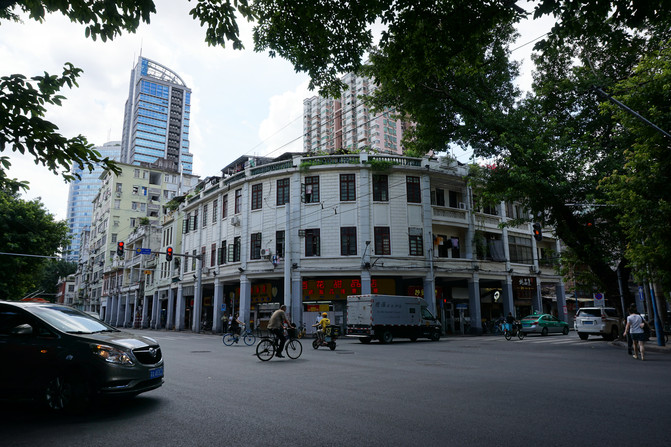
The characteristic of Guangzhou arcade is that the portico is expanded and collated into corridors along the street. Above the corridor is a building, one side is open to the street, and the other side is a store window. Customers can freely choose goods along the corridor, and people live upstairs.
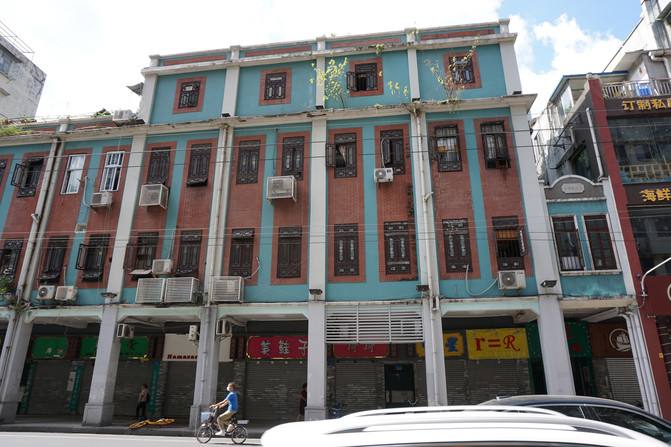
Shops in the arcade can borrow colonnade space to open their storefronts and display products to attract customers.

In the morning, the roads are not too noisy, dense alleys, friendly neighborhoods, and the diet of civilians show a strong human touch everywhere, allowing you to experience the most authentic atmosphere of Guangfu life anytime and anywhere.


Nowadays, walking under the arcade, you can still feel the Guangzhou people's love for arcade and the noisy city customs. The crowded roads and unique arcade buildings all demonstrate the unique charm of Guangzhou's old city.

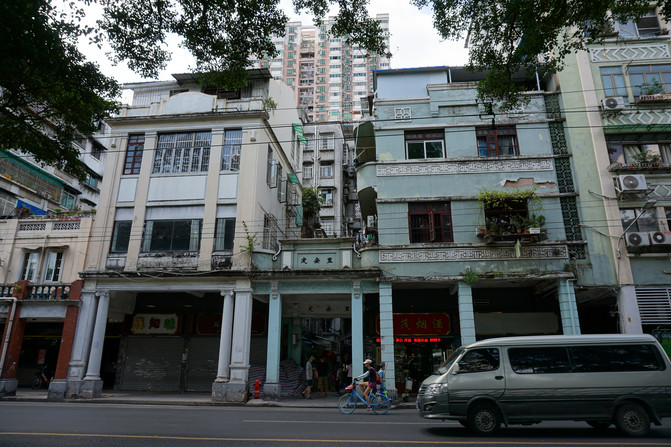
Lu Xun Memorial Hall in Guangzhou
Address: No. 215, Wenming Road, Guangzhou City
Tickets: Online reservation in advance, free entry
Everything in the old city made us curious, and before we knew it, we arrived at No. 215 Wenming Road, Guangzhou City. There are now three identities here.
Above the middle arch is the "Guangdong Provincial Sun Yat-sen Library", on the left is the "Guangzhou Lu Xun Memorial Hall", and on the right is the "Former Site of the First National Congress of the Chinese Kuomintang".

The combination of three identities shows that there is a bit of mystery here. Check the appointment code and health code, measure your body temperature and enter.

It suddenly became clear in front of me, and the square surrounded by tall buildings was covered with fragrant grass. There was a large green lawn surrounded by ancient trees.
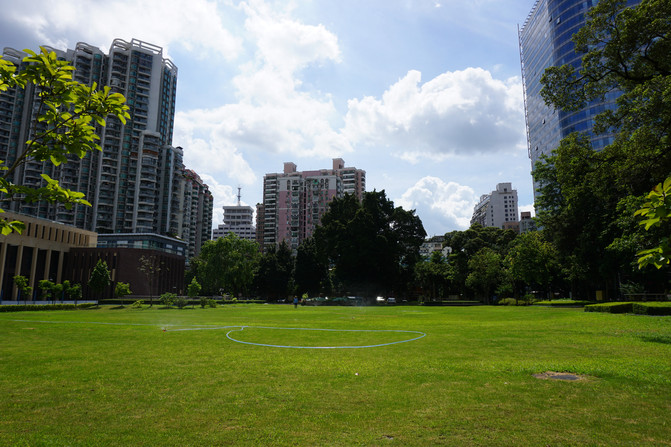
This square has a lot of history. It is the former site of Revolution Square. It was built in the late Qing Dynasty and was once the sports ground of the Guangdong and Guangxi Normal Schools. In 1924, National Guangzhou University opened a runway here and built Guangzhou's first standard sports stadium. The province's sports games and large-scale gatherings in Guangzhou were held here one after another. In 1924, Sun Yat-sen delivered a speech in the square. In 1926, the National Revolutionary Army vowed to launch the Northern Expedition here. The square is therefore also known as the "Revolution Square".


This was once the Guangdong Gongyuan in the Qing Dynasty. It was built in 1684. It was the Guangdong rural examination room in the Qing Dynasty and one of the four major Gongyuan in China in the late Qing Dynasty. In 1906, the imperial examination was abolished, and the Gongyuan was transformed into the Guangdong and Guangxi Higher Normal School. During the Republic of China, it was successively the site of National Guangdong Normal University, National Guangdong University and other schools. In 1986, a new building of Zhongshan Library in Guangdong Province was built on the former site of Gongyuan.

The three-story creamy yellow main body and the green glazed tiles covered the roof of the Guangdong Provincial Sun Yat-sen Library.

Entering the gate, a road more than ten meters wide made of small stones leads straight forward to a small courtyard surrounded by a wall made of yellow columns and iron railings. You need to check the reservation code to enter here again. This yellow building facing south turned out to be the bell tower of Guangdong Normal University. The Bell Tower was built in the 31st year of Guangxu of the Qing Dynasty and got its name because of the four-sided clocks set up on the roof. The brick-wood structure is like a "mountain" on the plane. In the middle is a 5-story bell tower, equipped with clocks and oblong glass windows on all sides, and a flagpole on the top. The main entrance is an arch-shaped colonnade.

The courtyard door looks back at the city behind it, and the green trees under the blue sky and white clouds hold up tall buildings of different shapes.

The text on one side of the wall introduces the general situation of Lu Xun Memorial Hall in Guangzhou.

The ancient trees in the park are ancient and layered.

A century-old tree with fine leaves, a century-old kapok, silver birch, cedar... Let this place have eye-dripping green and cistanche.

In January 1927, Lu Xun was invited to serve as chairman of the Department of Literature and dean of academic affairs at Sun Yat-sen University, during which time he lived on the second floor of the Bell Tower. So the Bell Tower was turned into Lu Xun Memorial Hall here. Guangzhou Lu Xun Memorial Hall was established in 1957, with the Bell Tower as the venue. It is one of the six Lu Xun Memorial Halls in the country.

The main entrance of the old site is an arched circular colonnade with a platform on the corridor and a foyer under the corridor.

Entering the porch, there is an identity symbol hanging on each side of the door: on the right side is the "Lu Xun Memorial Hall", and on the left side is the "First History Exhibition Hall of the Cooperation between the Kuomintang and the Communist Party". You can imagine that this bell tower has many historical stories.

Entering, the long corridor has a sense of depth. There are road signs on the wall guiding us to different exhibition areas.

On the right side of the door is the tourist service area, and on the left side are the two exhibition parts. We will visit it slowly later.

The long and narrow visitor center looks very spacious, with several rows of indomitable bookshelves forming a "U" shape.

A long table is available for tourists to rest or read.

A long table in front of the window has different commemorative medals for tourists to keep as souvenirs.

A distinctive commemorative medal

A passage of Lu Xun's article was written on the blackboard in chalk


Return to the corridor and continue your tour to the left.

This is one of the contents of the exhibition at the memorial hall-"Bell:1924--The First National Congress of the Kuomintang of China, the First Historical Exhibition of Cooperation between the Kuomintang and the Communist Party"

Part 1: Frustration and brewing. This part traces the arduous process of Dr. Sun Yat-sen leading the Kuomintang to carry out the democratic revolution, the changes in the Kuomintang organization, and Mr. Sun Yat-sen's historical choice to reorganize the Kuomintang and unite with Russia and the Communist Party.

The scene of the meeting between Sun Yat-sen and Li Dazhao reappeared.

Part 2: Convening and cooperation. This part reproduces the historical scene of the First National Congress of the Chinese Kuomintang, important decisions, major achievements, and the reconstruction of Kuomintang organizations at all levels under the first cooperation between the Kuomintang and the Communist Party.

Photos of Kuomintang members at all levels

The development status of the Kuomintang in various places.

Part 3: Rise and Impact. With the joint efforts of the Kuomintang and the Communist Party of China, Guangdong University and Whampoa Military Academy were established to cultivate revolutionary military talents.

Model of the Zhongshan Ship


The national revolution surged rapidly, Guangdong was unified, and the Northern Expedition progressed smoothly.

Uniform of the Northern Expedition Army


We followed the three parts of the exhibition to learn about the history of the First National Congress of the Kuomintang of China and the history of the first cooperation between the Kuomintang and the Communist Party.

This exhibition hall-"On the Bell Tower-Lu Xun and Guangdong". Since it is a Lu Xun Memorial Hall, Lu Xun's life must be the main body of the memorial hall.

This theme is divided into five parts to outline a past. "The Road to Life-A Glance of Lu Xun's Life", this exhibition hall reviews Lu Xun's extraordinary life as a great man of modern thought and culture in China through words and pictures, and his far-reaching influence on the ideology and culture of modern Chinese society.
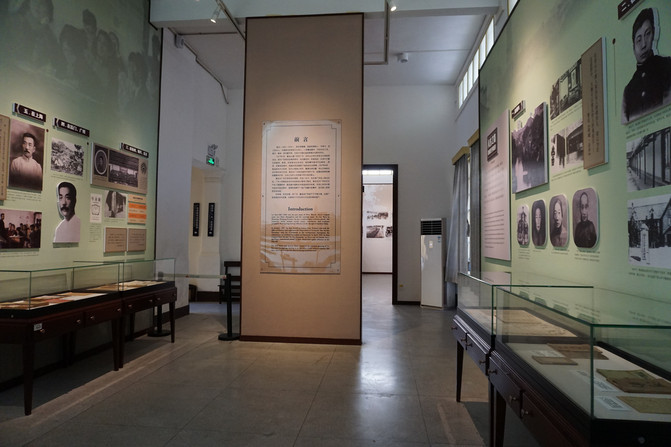
"Dream of the South-Lu Xun's Guangzhou Years"

It shows Lu Xun's busy work and life after he arrived as chairman of the Department of Literature and Dean of Academic Affairs at Sun Yat-sen University in Guangzhou in January 1927.


On March 29, 1927, Lu Xun resigned from his position at CUHK and moved from Bell Tower to Baiyunlou on Baiyun Road.

Lu Xun devoted himself to literary creation, while sorting out old works and translating foreign works.

In Guangzhou, Lu Xun, in addition to teaching and writing, also had days when ordinary people were leisurely. Here, old photos are used to set off the background and scenes to restore the restaurants, bookstores and teahouses that Lu Xun often visited. It shows Lu Xun's life experience while in Guangzhou.

Lu Xun and Xu Guangping went to Yanfang Photo Studio to take a group photo;

Lu Xun gave speeches, outings, shopped, dined, drank tea, and watched movies in Guangzhou, leaving many Guangzhou speeches and Guangzhou memories. Lu Xun's real market life in Guangzhou appears in front of us through words and pictures.

At the beginning of 1927, in order to give Guangzhou youth the opportunity to read more revolutionary literary and artistic books, expand the influence of Weiming Society books and periodicals and Mangyuan magazine, spread new ideas and new cultures to young people, and cultivate new literary seedlings in the south, Lu Xun decided to open a bookstore-Beixin Bookstore. This bookstore was also the only time Lu Xun had as a boss.

"Friends of Celebrities-Lu Xun and Famous People in Guangdong"
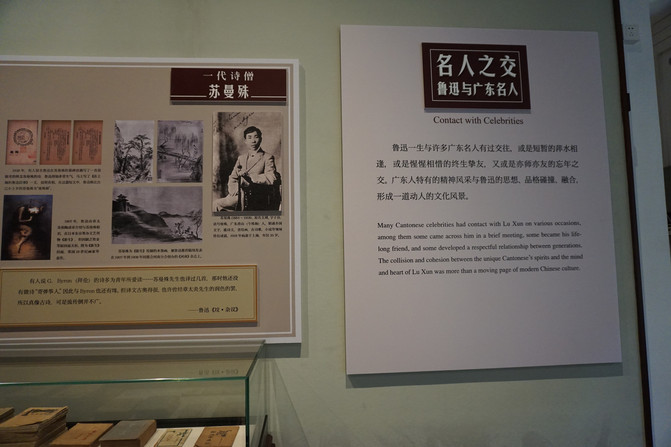
It shows the famous people in Guangdong who interacted with Lu Xun. They are either short-lived strangers, lifelong best friends, or friends who are friends who are both teachers and friends.

The collision and combination of the unique spiritual style of Cantonese people and Lu Xun's thoughts have formed a unique cultural landscape.

"The Way of Youth-Lu Xun and the Woodcut Youth in Guangdong",

As a pioneer of China's emerging woodcarving movement, Lu Xun guided and cultivated a group of young woodcarving people from Guangdong in the process of wholeheartedly supporting Chinese woodcarving creation, which had a profound impact on the rise and development of emerging woodcarving in Guangdong.

"Love of Fengzi-Lu Xun and Xu Guangping"

It shows the life story of Lu Xun and Xu Guangping meeting, getting to know each other, falling in love with each other, and sharing weal and woe.

These words were all the contents of letters between Lu Xun and Xu Guangping. Communication has always been an important way of communication between Lu Xun and Xu Guangping. The communication between them developed from the initial discussion of student movements and social issues to banter about family, meals, etc. The letter truly and vividly records the "truth of what they experienced" from teachers and students to lovers, and then to family members.



Mailbox boxes and postboxes in the corridor.

Here is a scene display of the bedroom and study room of Lu Xun's former residence in Shanghai. On April 11, 1933, Lu Xun lived at No. 9, Daliu New Village, Shanghai until his death. In this room on the second floor, he wrote selflessly until the last moment of his life.


Comments of Lu Xun from all walks of life

Corridor between buildings

In 2014, during the renovation of the former site of the First National Congress of the Kuomintang, during the foundation reinforcement construction, construction workers discovered that there were artificial structures in the auditorium. Archaeologists determined that they were the base of Guangdong Gongyuan House. In 2015, during the construction of the courtyard of the former site of the First National Congress of the Communist Party of China, the stone road and a Gongwell next to Gongyuan No. house were discovered. In order to present the historical scene of Guangdong's imperial examinations and restore a corner of the original historical appearance of Guangdong Gongyuan, this miniature display was launched on the original site.

The right passage of Guangdong Gongyuan House.

gongjing

The Bell Tower Auditorium was built in the 32nd year of Guangxu of the Qing Dynasty (1906). It is the auditorium on the first floor of the Bell Tower of the former Guangdong Normal University.

In January 1924, Sun Yat-sen held the First National Congress of the Kuomintang of China here with the participation of Communists. At the meeting, Sun Yat-sen re-explained the Three People's Principles and the idea of cooperation between the Kuomintang and the Communist Party. The auditorium has now been restored to its original appearance, and the display layout of the Kuomintang's "First National Congress" has been restored, with a long red carpet leading to the rostrum.

The national flag of the Republic of China and the flag of the Chinese Kuomintang are hung on the rostrum, and the national flag of ten thousand is hung in the middle of the venue.

Go up the stairs and continue to visit

There is a statue of Sun Yat-sen on the second floor of the auditorium

The recording of Mr. Sun Yat-sen's speech "The Policy to Save the Nation" with a southern Fujian accent was played in the hall

There is a platform on the second floor of the auditorium, and dozens of benches sit around the auditorium.
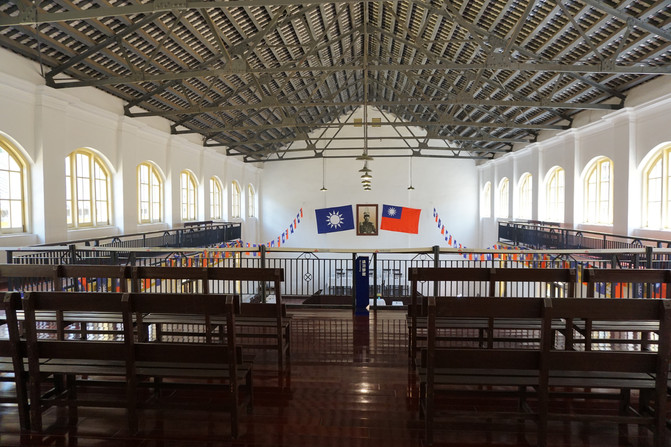
Overlooking the venue from the second floor

The second floor overlooks the corridor
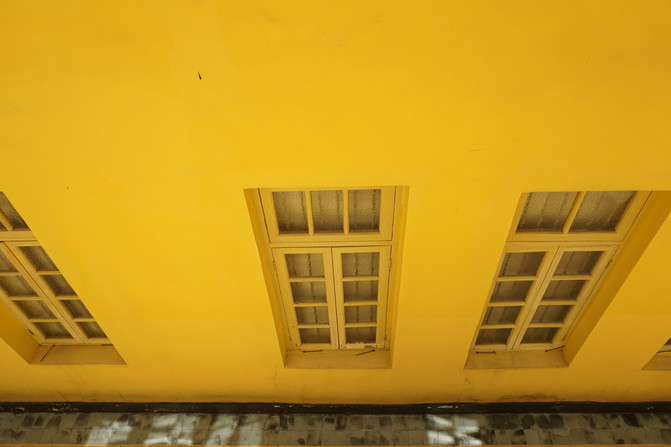
On the second floor, there is an exhibition "Mr. Guangdong: Style of Guangdong Scholars in the Republic of China".

Guangdong scholars are starry. This exhibition selects 13 scholars born in Guangdong to review and read them to commemorate these gentlemen, promote Lingnan culture, and enhance cultural confidence.



There is a very small room here to introduce Xiao Hong from Hulan River to Yinhe. Through detailed words and pictures, Xiao Hong's bumpy life destiny was told. A lifelike character emerged in front of me. The unique stubbornness and admirable courage of the women of the Republic of China deeply infected me.

In Xiao Hong's life and her creative career, Lu Xun gave her a lot of support and encouragement and practical help. In 1935, with the support of Lu Xun, he published his famous work "The Field of Life and Death".



"A Mountain-Ouyang Mountain's Literary History and Document Display". In 1927, here, Ouyang Shan became Lu Xun's student, and Lu Xun became his spiritual mentor throughout his life. In 2017, here, the Ouyang Mountain showroom was adjacent to Lu Xun's former residence. A literary past has continued, and another new story in Guangdong literature.

Round arch on the second floor, long corridor
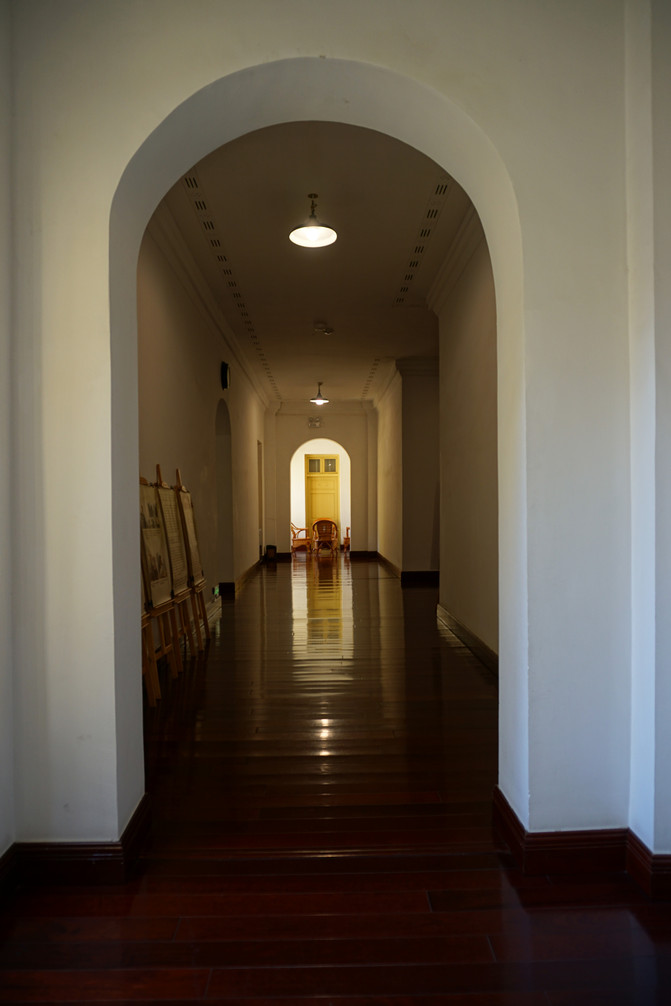
The exhibition board on the promenade displays Lu Xun's "On the Bell Tower". The article records his feelings when he first arrived in Guangzhou.

The conference room of Sun Yat-sen University is on the left, and Lu Xun Bookstore is on the right.

On January 18, 1927, Lu Xun came to Guangzhou at the invitation of Sun Yat-sen University and served as director of the Department of Literature at Sun Yat-sen University. He worked and lived here from January to March 1927. Later, he moved to Baiyunlou on Baiyun Road.
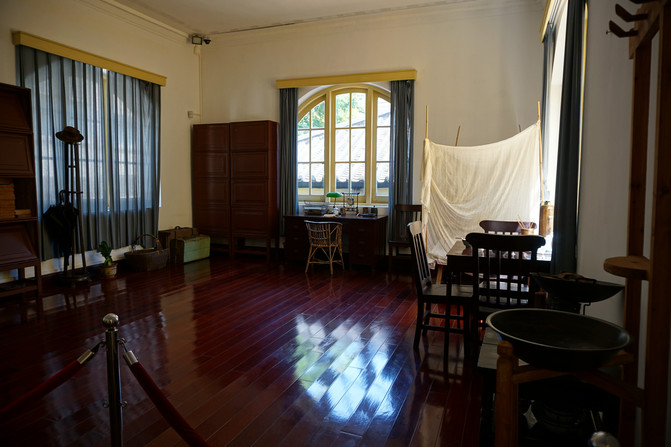

In the conference room of Sun Yat-sen University, Lu Xun presided over 7 academic meetings here during his tenure as director of academic affairs at Sun Yat-sen University.

Look out the window on the second floor.

Diverse colors and rich layers



Downstairs are surrounded by colonnades. The first half of the bell tower is two-story, and the second half is one-story. There are parapet railings on the outer eaves of the front building. There are walls in the form of small watchtowers at the corners around. There are arched windows on the upper level, and there are double-pilled pilasters between the windows.

After the visit, I stayed in this green courtyard for a while. Lu Xun's familiar works are written on the benches in the courtyard. Take a rest here and look at the bell tower in front of you. Bell Tower, Lu Xun and Guangdong formed an indissoluble bond. Lu Xun had an intersection with Guangdong for more than eight months in 1927. Eight months is so short that this past is often ignored. The Lu Xun Memorial Hall allows us to get closer to Lu Xun, touch history, and connect the past, present and future of history.

There are six Lu Xun memorial halls across the country. In order to commemorate this great writer, thinker, and revolutionary in modern China, memorial halls were established in the places where he once worked and lived. We have been to three places, Shanghai, Shaoxing and Guangzhou. Although they are all Lu Xun Memorial Hall, they all have their own characteristics. Guangzhou Lu Xun Museum not only contains Lu Xun, but also the former site of the First National Congress of the Chinese Kuomintang. The content here is richer.

Previous Article:I slept in the first international five-star hotel in Panyu
